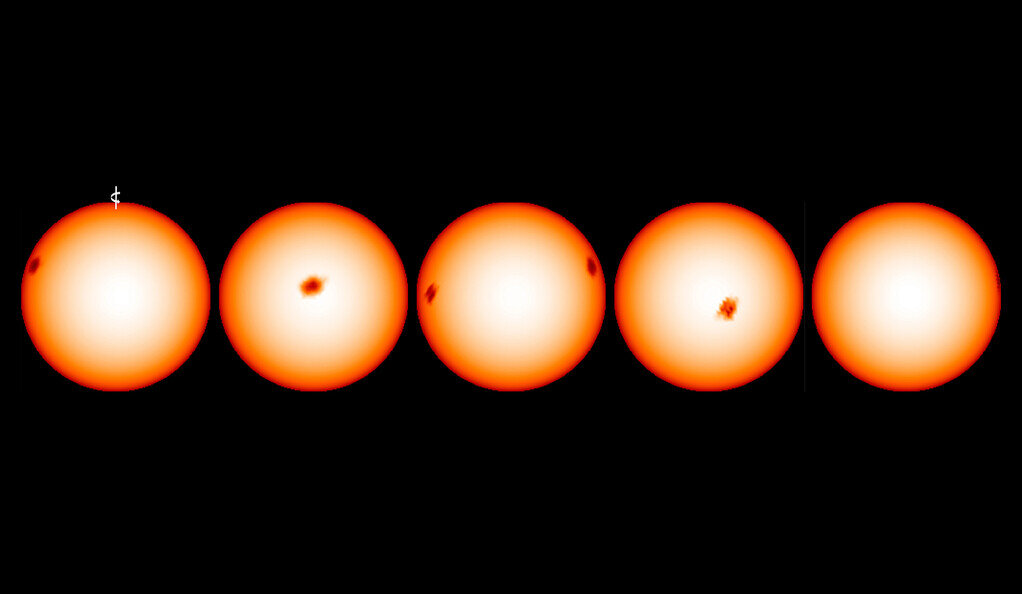
Reconstructed surface of Epsilon Eridani, a spotted star with each panel showing that the star has advanced one-fifth its rotation. Credit: Visualization: Sam Cabot
Astronomers looking for Earth-like planets within other solar systems made a breakthrough when they looked closer at stars.
An international team of researchers led by Yale Astronomers Rachael Roettenbacher and Sam Cabot has developed a new technique that distinguishes between light signals from stars and those coming from planets orbiting them.
The Astronomical Journal has accepted a study detailing this discovery.
Roettenbacher is a Yale 51 Pegasi B postdoctoral fellow and the lead author of this paper. We create a map that shows the surface using one of the data sets. This allows us to uncover more detail in the radial velocity data, which we use as a way of searching for signals from small planets.
"This procedure shows how valuable it is to have multiple types of observation at the same time."
Radial velocity has been used by astronomers for decades as a way to search for exoplanets within other solar systems. Radial velocity is the motion of a star in relation to an observer's viewline.
Astronomers search for changes in the velocity of a star that could be due to the gravitational pull from an orbiting planet. This data comes via spectrometersinstruments that look at light being emitted by a star and stretch the light into a spectrum of frequencies that can be analyzed.
Astronomers have been trying to find Earth-like planets for many years, but they have hit a roadblock that has impeded their progress. Convecting plasma from stars can create a boiling cauldron that distorts measurements radial velocity and obscures signals from small, rocky worlds.
This problem is being addressed by a new generation advanced instruments. This includes the EXtreme PREcision Spectrograph, (EXPRES), designed and built by Fischer's Yale team. Also included are the Transiting Exoplanet Survey Satellite(TESS) and the Center for High Angular Resolution Astronomy.
The researchers used TESS data for the new study to reconstruct Epsilon Eridani's surface. This star is located in the southern constellation Eridanus and can be seen from most of Earth's surface. The researchers then searched for starspotscooler areas on the star's surface due to strong magnetic fields.
Cabot stated, "With the reconstructions you can know the locations and the sizes of starspots and how fast the star rotates." "We created a method to tell you the type of signal that you would see using a spectrometer.
The researchers then compared the TESS reconstructions to EXPRES spectrometer data from Epsilon Eridani.
Fischer stated that this allowed Fischer to tie the contributions of the radial velocity signature directly to features on the surface. "The radial velocity signatures of the starspots match perfectly with EXPRES data."
Researchers also used interferometry to detect Epsilon Eridani's starspot. This was the first interferometric detection on a star like the Sun.
Interferometry is a technique that combines separate telescopes to create larger telescopes. The CHARA Array is the largest optical interferometer in the world, and was used by the researchers to accomplish this.
Roettenbacher stated that she and her coworkers will use their new technique on sets of interferometric observation to directly image the surface of a star, and to determine its contribution to its radial velocity.
Interferometric imaging cannot be used for many stars, as the star must be near and bright. Roettenbacher stated that there are only a few stars where we can apply our pioneering approach.
John Brewer, a former Yale researcher, and Lily Zhao (now at the Flatiron Institute) are co-authors of the study.
Continue reading A super-Earth discovered orbiting a red dwarf star
